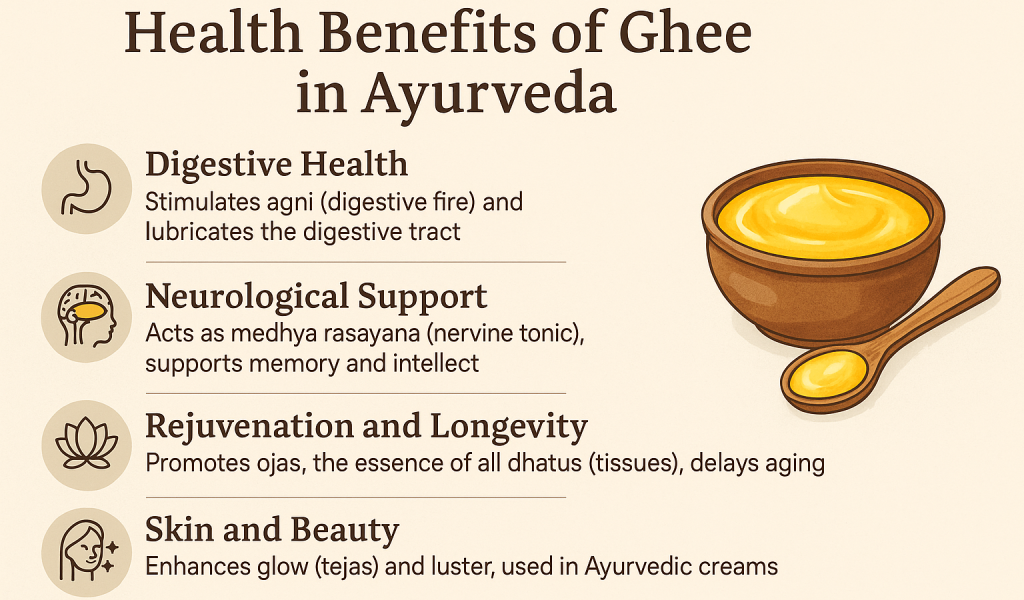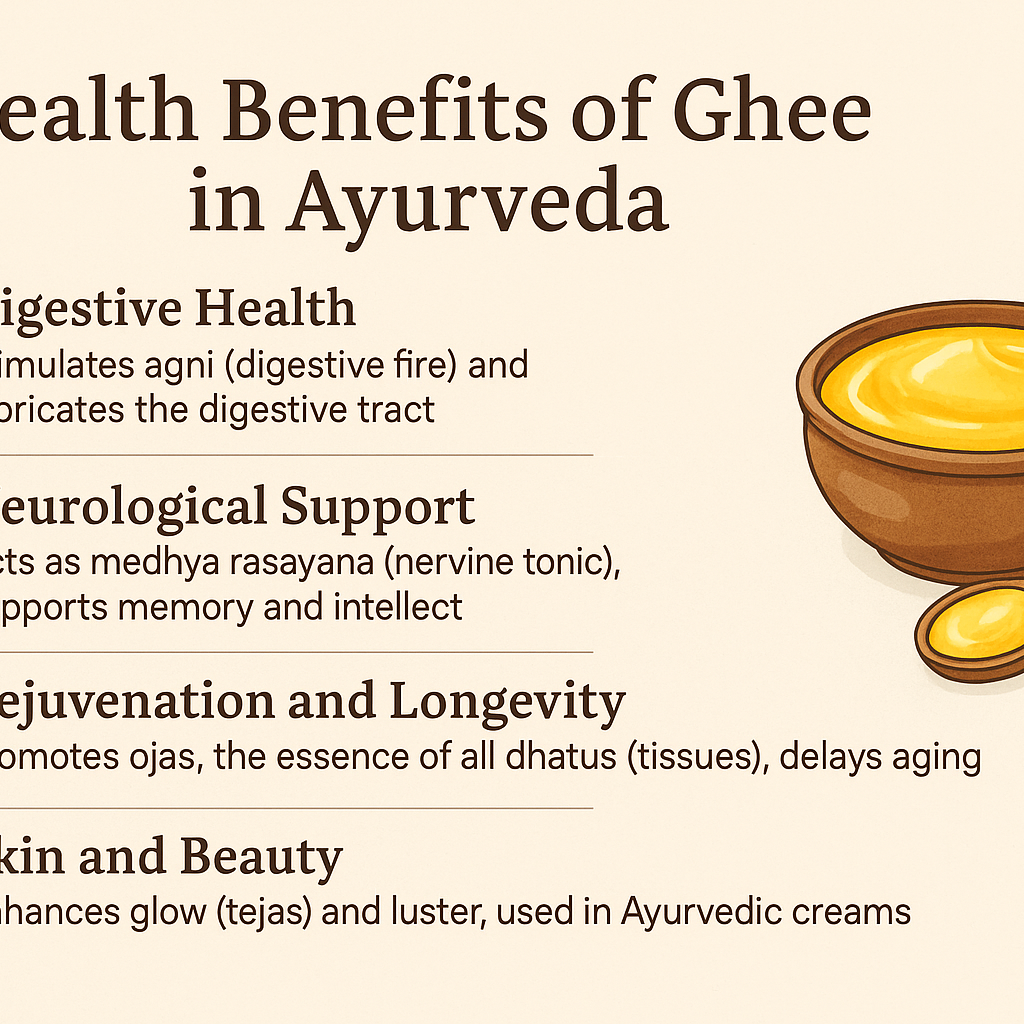11 July 2025
Category: Ayurveda & Traditional Medicine I Healthy Fats & Oils I
Health & Wellness
Written By:
Vedanti More (PharmD)
Reviewed By:
Ayurvedacharya
Dr. Gaurav Pathare (BAMS)

“शस्तं धीस्मृततमधातिबलायुुःशुक्रचक्षुषाम्”
“बालवृद्धप्रजाकातततसौकुमाययस्वरार्थथनाम् ।
क्षतक्षीणपरी सपयशस्त्रातिग्लतपतात्मनाम् ॥”
“वाततपत्ततवषोतमादशोषालक्ष्मीज्वरापहम् ।
स्नेहानामुत्तमं शीतं वयसुः स्थापनं परम् ॥”
“सहस्त्रवीर्यं तावत् अति-वीर्यं काम्यसहस्त्रकृत्”
Translate Literally as
Ghee is highly beneficial; it removes dullness and enhances intellect, memory, strength, longevity, semen quality, and vision. “It is nourishing for children and the elderly and enhances fertility, voice, and softness, and it is helpful for those injured, weakened, or suffering from deep exhaustion or emotional decline.” It relieves Vata, heat, dryness, wasting diseases, and fever. It is the best among fats/oils, cooling in nature, and helps maintain youth.” It is of immense potency, extremely powerful, and capable of fulfilling numerous desires.”
Ref-
Ashtang Hridaya Sutrasthan 5/37-39, Charaka Samhita, Sutrasthana 13.14-15)
घृतं सवेषां ओषधीनां अन्नानां च श्रेष्ठम्।
घृतं स्मृततबुद्ध्यतिबलायुषुः शुक्रचक्षुषां तहतम्।
बालवृद्धक्षीणक्षताततपतव्रणदग्धतवषमत्तमूर्थछितज्वररणां च।
संतश्रतं च सम्यक् पातचतं शतगुणं विवतित॥
English Translation
“Ghee is the best among all medicines and foods. Ghee excels in improving memory, intellect, strength, longevity, reproductive capacity, and vision. It is highly beneficial for children and the elderly, the weak, the injured, and for heat-related disorders, wounds, burns, intoxication, bone diseases, fever, etc. Properly administered in the right dose, it multiplies wellness a hundredfold.”
Ayurveda, the ancient and holistic system of medicine from India, considers food not only as a means of nutrition but also as an effective tool for both prevention and healing of diseases. Among all dietary substances, ghee holds a sacred place due to its wide-ranging therapeutic benefits. Classical Ayurvedic texts like the Charaka Samhita and Sushruta Samhita praise its qualities, highlighting its ability to promote Ojas (vital essence), balance Agni (digestive fire), and serve as a Sattvic (pure and harmonious) food that can nurture both body and mind.
In every Indian home, ghee holds a place of honor not just as an ingredient but as a symbol of nourishment and tradition. It is used in almost every food preparation, sometimes as a substitute for refined oil, and often to enhance the flavor and richness of a dish. Consuming ghee (clarified butter) is commonly associated with good health; someone who includes ghee in their daily diet is often believed to have better vitality and well-being. From sweets and everyday curries to rice, biryani, parathas, and roti, ghee adds a distinct taste and is traditionally seen as a source of “good cholesterol” and energy.
Among all ghees, cow’s milk ghee (Ghṛita) (henceforth only ghee) is considered a supreme health-promoting substance in Ayurveda. Treated in high regard as a Rasayana (rejuvenator), ghee plays a vital role in diet, medicine, and spiritual practices. This paper discusses ghee’s pharmacological actions, therapeutic uses, and significance in Ayurvedic formulations.
Ayurvedic Properties of Ghee in Sanskrit
Synonyms: Ghṛita, Sarpis, Payasya
Dosha Action: Vata-Pitta Shamaka (alleviates Vata and Pitta), in moderation, balances Kapha Rasa (Taste): Madhura (Sweet) Virya (Potency): Sheeta (Cooling)
Vipaka (Post-digestive effect): Madhura (Sweet) Guna (Qualities): Snigdha (unctuous), Guru (heavy), Mridu (softening), Sara (mobility-enhancing)
Health Benefits in Ayurveda
Digestive Health
Cow’s ghee plays several key roles in promoting a healthy gastrointestinal system: Enhances Agni (digestive fire) without aggravating Pitta: Ghee enhances the body’s digestive strength or Agni, which is essential for proper breakdown, absorption, and assimilation of food. Reduces Inflammation: The anti-inflammatory properties of ghee help calm irritated gut lining; and may be beneficial in conditions like gastritis, IBS, and colitis. Useful in conditions like peptic ulcers, gastritis, and IBS
Neurological Benefits
Cow’s ghee is recognized as a potent Medhya Rasayana a rejuvenating tonic that nourishes and strengthens the mind and nervous system. It supports memory (smriti), intellect (dhi), and mental clarity, making it valuable in cognitive enhancement and stress relief. Ghee is widely used in traditional Ayurvedic therapies such as Nasya (nasal administration), Shirodhara (oil flow therapy over the forehead), and Basti (medicated enema), where it helps calm the nervous system, balance Vata dosha, and improve neurological function. Its ability to penetrate deep tissues and cross the blood-brain barrier makes it an ideal carrier for delivering medicinal herbs to the brain.
Rejuvenation and Longevity
Cow’s ghee plays a vital role in Ayurvedic rejuvenation therapy. It is known to promote Ojas the subtle essence of all bodily tissues (dhatus) which is considered the basis of vitality, immunity, and emotional resilience. By nourishing the tissues and balancing the doshas, ghee helps delay the aging process, enhance immune function, and support overall longevity. Regular consumption, in appropriate amounts, is believed to foster strength, stamina, and youthful vigor over time.
Skin and Beauty
Cow’s ghee is cherished in Ayurveda for enhancing skin glow (Tejas), radiance, and natural luster. Its deeply nourishing and moisturizing properties help maintain skin elasticity, softness, and clarity. Rich in essential fatty acids and antioxidants, ghee supports skin regeneration and is widely used in Ayurvedic creams, lepas (herbal pastes), and wound-healing formulations. It soothes inflammation, promotes faster healing of cuts and burns, and helps reduce dryness and signs of aging, making it a holistic skin rejuvenator from within.
Detoxification and Panchakarma
In Ayurvedic detoxification therapies, cow’s ghee plays a foundational role, especially in Snehana as a preparatory step in Panchakarma, ghee is administered orally to loosen and mobilize fat-soluble toxins stored in deep tissues. This process prepares the body for cleansing procedures like Vamana (therapeutic emesis) and Virechana (therapeutic purgation). Due to its unique ability to penetrate cellular membranes and bind with toxins, ghee aids in their safe and effective elimination, facilitating deep detoxification and systemic rejuvenation.
Medicinal Uses in Classical Texts
Charaka Samhita: “Among all oils and fats, ghee is the best.” Mentioned as Yogavahi: enhance the efficacy of herbs with which it is combined
Sushruta Samhita: Emphasized for wound healing, eye diseases, and ulcers
Bhava Prakasha: Discusses ghee’s use in disorders like epilepsy, insanity, chronic fever, and infertility
Scientific Studies and Modern Validation
Recent research confirms several traditional claims:
Rich in butyric acid – supports gut health
Contains omega-3 fatty acid
Antioxidant, anti-inflammatory effects
Supports cholesterol metabolism when consumed moderately
Spiritual and Ritual Significance
Used in Yajnas (Vedic fire rituals) – considered to purify air
Lamp oil in temples – symbol of purity and clarity
Precautions and Contraindications
Avoid in: Acute indigestion, liver disorders, high Kapha conditions (obesity)
Not suitable in excess during hot weather
Rule: Always use ghee in moderation,
Preferably under supervision for therapeutic use
Conclusion
Cow’s ghee holds a sacred and therapeutic status in Ayurveda, revered not just as a food, but as an integrative healer. It nourishes the body, mind, and spirit, making it an essential component of Ayurvedic lifestyle, rituals, and medical therapies. In today’s era of rising interest in natural and integrative health, ghee stands out as a time-tested remedy offering a seamless blend of nutrition, rejuvenation, and healing. Rooted in very old wisdom yet supported by modern research, cow’s ghee continues to be a golden bridge between tradition and wellness.
References
- Charaka Samhita (Sutrasthana, Chikitsasthana)
- Ashtang Hridaya Sutrasthan 5/37-39
- Sushruta Samhita
- Bhava Prakasha Nighantu
- Research articles on PubMed and AYUSH publications

